Top 10 tips for deploying multiparameter sondes in marine environments
Whether you're monitoring water quality in an estuary, harbor, or coastal reef, marine environments present unique challenges for collecting accurate, reliable data. From saltwater corrosion to biofouling, deploying a water quality instrument like the EXO Sonde in the ocean requires thoughtful planning and regular maintenance.
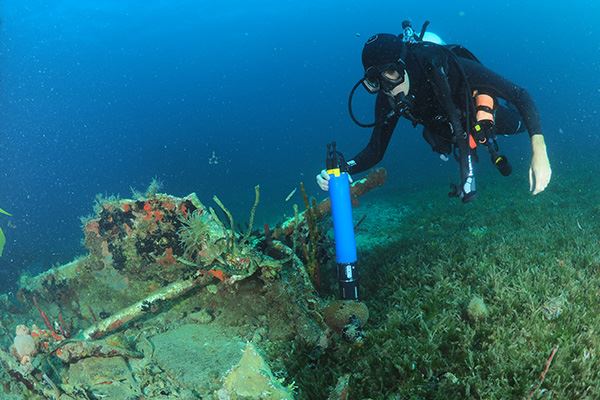
Deploying water quality instrumentation—such as the YSI EXO2 Sonde shown here—in marine environments requires careful planning to ensure accurate, reliable data are collected throughout the deployment period. Photo credit: Jon Fajans
As an Applications Specialist, I work with YSI to install and maintain instruments to test sensor technology, new materials, and anti-fouling accessories.
We maintain two sites in the harsh environment of the Gulf of Mexico. One is typical of what you might find in most coastal areas, while combined sewer overflows (CSOs) frequently inundate the other. Many older municipalities suffer from aging infrastructure that combines stormwater and sewage in the same pipes. Heavy rain events can easily overwhelm these systems, resulting in raw sewage being discharged into waterways, posing unique challenges for water quality monitoring.
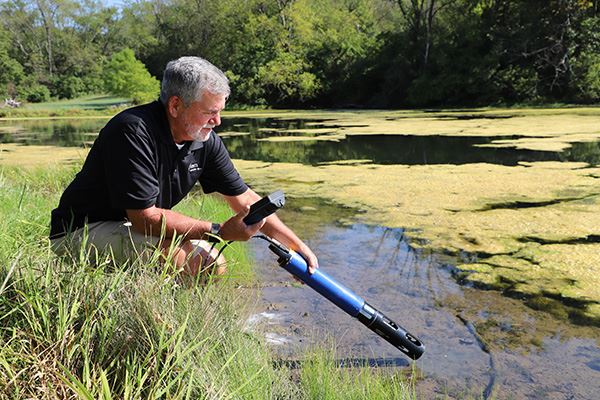
Curtis Buter has spent decades helping YSI customers install and maintain a wide variety of water quality instrumentation.
From my experience, I have found field-tested strategies that will help you overcome marine monitoring challenges and ensure reliable, defensible data in even the harshest coastal conditions. This blog covers my top 10 tips for marine deployments, from site selection and anti-fouling strategies to maintenance protocols and data integrity practices. Many of these recommendations also apply to other environments.
1. Define your monitoring goals
Before anything else, determine what you want to measure and why. Are you capturing baseline data, investigating a pollution event, or monitoring seasonal changes? It could be compliance-related monitoring. Whatever your goals, they will inform everything from deployment frequency to sensor selection.
For example, effective monitoring of a pollution event might require monitoring the most common water quality parameters, including conductivity, temperature, dissolved oxygen, pH, and turbidity, as well as parameters related to pollution, such as fluorescent dissolved organic matter (fDOM).
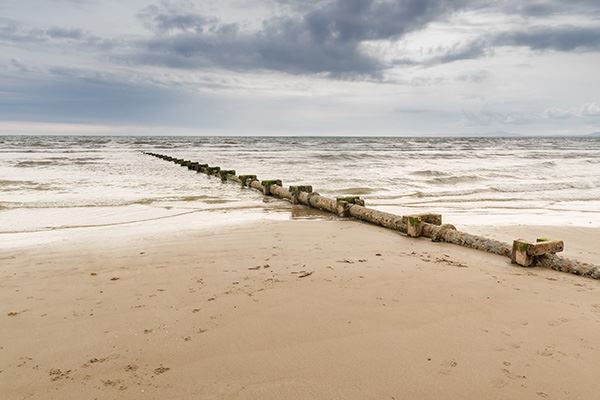
Outfall pipes discharge treated wastewater into the ocean, making them important sites for marine water quality monitoring. Monitoring near these outfalls helps protect ecosystems, safeguard public health, and ensure regulatory compliance.
2. Choose the right deployment duration
Short-term discrete sampling is great for targeted studies. The problem with discrete sampling has always been that it only gathers a snapshot of the ecosystem, running the risk of missing changes related to natural events, such as heavy rainfall or algal blooms. The benefit of continuous deployments is not only the ability to collect more data, but they also allow you to use your resources for other critical environmental studies.
Many have asked me, “How long can I leave my instruments in the water before scheduling a site visit?” There is no simple answer to this question. How severe is the biofouling in this area? How old is your instrumentation? Are there seasonal variations that will impact this deployment? Is the site telemetered so you can see from your office if there is a problem, or does the sonde stand alone, logging data internally?
There are many variables involved, and only you can determine how long a sonde can be left deployed before encountering power issues or biofouling that interfere with the data. I advise people to start with more frequent visits and then gradually increase the amount of time between site visits as conditions allow.
There are many variables involved, and only you can determine how long a sonde can be left deployed before encountering power issues, biofouling, or sensor drift that might negatively impact the deployment and the data. I advise people to start with more frequent visits and gradually expand the amount of time between site visits as conditions allow, depending on the degree of biofouling and sensor drift.
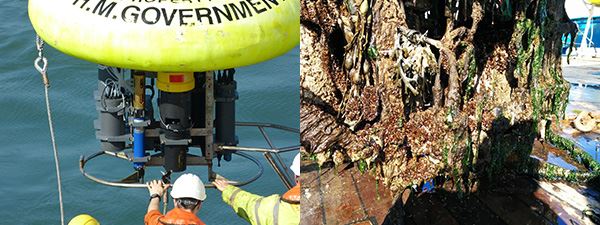
A water quality monitoring buoy before deployment (left) and after deployment (right), demonstrating the extensive biofouling that can occur in a marine environment.
You may find that your instrumentation is the limiting factor. Your sensor must be able to operate within factory specifications for as long as your deployment lasts to get reliable data. It has been my experience that I can easily leave my EXO Sondes in the water for 5-week deployments before I face the need to recalibrate my sensors.
Long-term deployments may be slightly more expensive upfront, but selecting a company with a reputation for high-quality instrumentation can help mitigate the overall cost of ownership. Long-term deployments require more robust power supplies, anti-fouling measures, and maintenance planning. Determine your timeline early so you can prepare accordingly. Remember, lost data points can never be recovered.
3. Select a representative and accessible site
Many factors must be considered when selecting your deployment site.
- Representativeness: Ensure the site reflects the overall water quality of the area
- Accessibility: Ensure you can safely reach the site for deployments and maintenance
- Security: Minimize risk from hikers, boat traffic, swimmers, or wildlife
- Permission: Ensure you have property access and permits if needed
It is often challenging to pick a site that meets all the above criteria. However, please do your best to minimize the risk and maximize the ease of access when choosing your site, while ensuring it is accurately representative of the area.
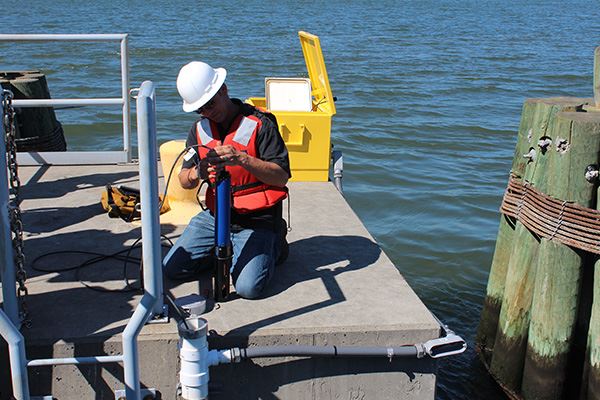
In this photo, a YSI EXO2 Multiparameter Sonde is serviced on an accessible, secure dock.
4. Pick the correct deployment method
Your method depends on depth, currents, site conditions, and study objectives. Common setups include:
- 316 stainless steel chains or PVC tubes for vertical or horizontal stabilization
- Fixed mounts on piers, pilings, or dock structures
- Buoy-based systems for midwater or offshore locations
- Vertical profilers to gather high-resolution depth profiles
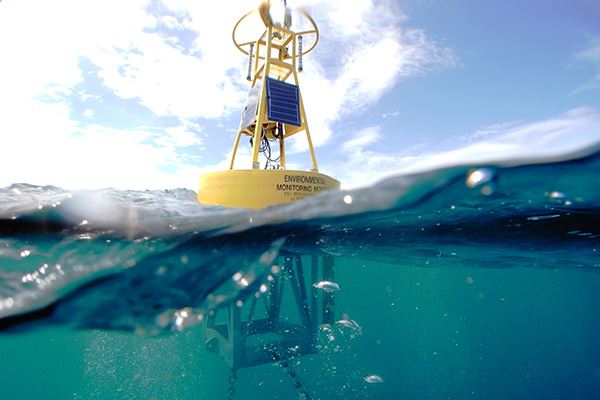
Monitoring buoys are ideal for midwater or offshore monitoring locations in marine environments. Photo credit: Jon Fajans
With any deployment method, consider if you will be using internal power from the sonde’s onboard batteries or external power from a larger battery within waterproof housing or mains power.
Whether you are deploying the sonde simply hanging from a chain or within a deployment tube, it must be deployed consistently at the same level every time it is retrieved and redeployed. This will maintain a consistent data set over time.
Use a heavy-duty 316 stainless chain and a carabiner for stand-alone sonde deployments. Secure the deployment tube with heavy stainless brackets and mark their position to ensure against shifting between deployments.
A vertical deployment tube is preferable; however, some locations require a more horizontal deployment angle due to low water levels at low tide. When using a PVC deployment tube, it is critical to have large holes above the sonde and many smaller holes near the sensor faces to ensure proper water flow over the sensors and avoid stagnation within the tube. Check out our vertical tube deployment guide for more information.
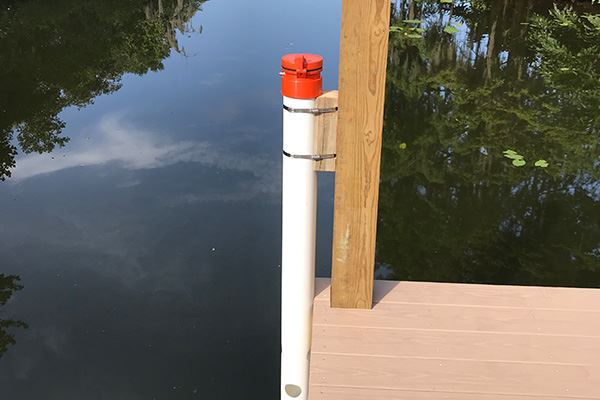
A deployment tube is a common deployment method for water quality instrumentation.
5. Prepare for biofouling
Saltwater environments are prone to rapid biological growth. In a highly active marine environment, biofouling will begin to get a foothold on your instruments in as little as 30 seconds. It is beneficial to implement the following deterrents.
- Use copper tape on the exposed sensors
- Use copper alloy sensor guards, such as the YSI EXO2 / EXO3 Anti-Fouling Guard
- Deploy anti-fouling wipers (if compatible)
- Use copper mesh to discourage creatures from inhabiting your sensor guard
- Apply C-spray to the instrument and sensor bodies (not sensor faces) to inhibit growth
It will simplify the removal of copper tape if you cover the sensors with something before installing the copper. For example, YSI offers thin heat-shrink sleeves that can be installed first and then covered with copper tape. Once the copper is depleted, run a blade down the copper/sleeve and remove it from the sensor; this is demonstrated in the image below.
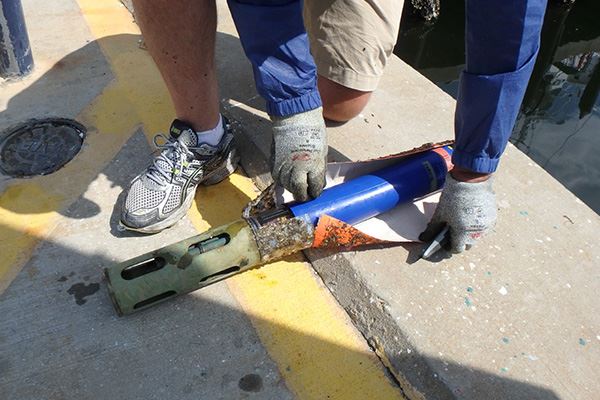
In this photo, Curtis cuts off a thin heat-shrink sleeve covered with copper tape. This method makes removing biofouling from a deployed EXO Sonde much easier.
Using a copper alloy can be very helpful in deterring biofouling from the area surrounding the sensors. The EXO Sonde features a robust central wiper that prevents biofouling from growing on the sensor faces between samples. The lack of a wiper like this will likely require more frequent site visits.
If you find that fish, crabs, or other marine life find your sensor guard a haven, you can deter them by installing copper mesh outside the sensor guard assembly.
Please note that your site visit frequency will vary depending on the level of biofouling.
Keep a particularly close eye on high-risk periods, such as warm months and seasons with increased nutrient input. The goal of introducing anti-fouling accessories is to allow your instrument to remain in the field as long as possible (reducing site visits and thus the overall cost of ownership) while maintaining the highest data quality possible.
Check out our webinar on How Anti-Fouling Works to learn more about common sources of fouling, how fouling impacts water quality data, anti-fouling technology, expert tips, and more!
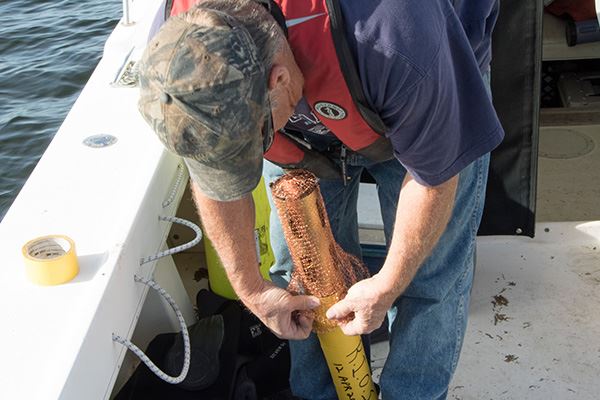
A YSI EXO2 Sonde with an anti-fouling guard being wrapped with copper mesh before deployment.
6. Conduct pre-deployment QA/QC
Before heading to the field:
- Calibrate each sensor with the appropriate standards
- Record baseline measurements in standards
- Verify communication with your laptop, phone, data logger, or handheld device
- Log sensor and instrument serial numbers and equipment configuration
- Always test your batteries with a voltmeter to determine their health
Following your Standard Operating Procedures and good lab practices is paramount to a successful calibration and a critical step to a successful long-term deployment. Remember, most temperature sensors cannot be calibrated; they are either good or bad and must be verified within specifications before calibrating your other sensors.
Also, if you have an EXO, check out our SmartQC Handbook to better understand your calibration results!
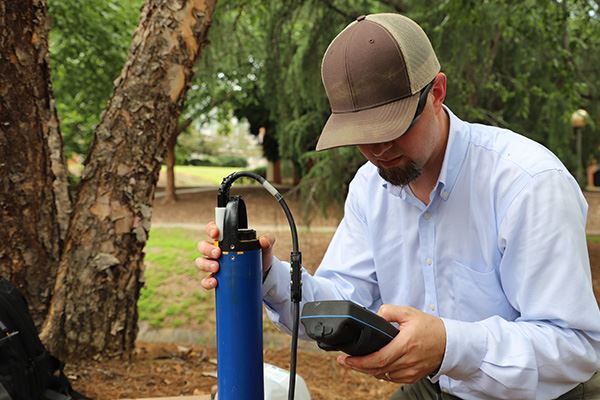
A successful calibration must be completed before deploying water quality sensors.
After calibration, I recommend running your instrument in an aerated bath overnight or at least a few hours. This data can be invaluable in verifying the health of your system before deployment. Never trust that a “new battery” is good; always test with a voltmeter before trusting your power will last the desired deployment. A pre-deployment checklist helps catch potential issues before they disrupt your study.
7. Maintain a routine schedule
Regular maintenance keeps your sonde and site performing at its best. Visit your site to:
- Clean the sonde and sensors; take a look at the user manual or our cleaning blog for more information
- Clean your deployment tube
- Clean your solar panel if the site is powered by external 12V power; a light coat of C-spray will allow rain to easily wash away debris
- Check for physical damage
- Swap or recharge batteries
- Recalibrate sensors or swap with a pre-calibrated sonde; the calibration frequency should reflect specific sensor needs and observed drift
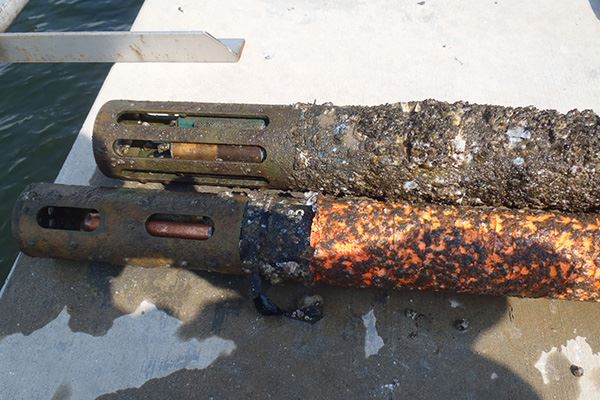
Biofouling will still accumulate even if anti-fouling measures are used, so a routine schedule for visiting your sites and maintaining equipment is critical!
Document each visit for quality assurance. Take photos when visiting the sites. Months later, when you are evaluating data, pictures can help you explain anomalies in your data.
Please do not neglect the maintenance of the site itself while concentrating on the sonde! It is crucial to inspect your deployment tube to ensure that the holes have not become clogged with biofouling, which can create a micro-environment within the tube. Always ensure your solar panel is clean and that all desiccant has been replaced before leaving the site. All the pieces of the puzzle are important and deserve your attention.
If you need help with your site, we offer maintenance services!
8. Conduct post-deployment QA/QC
When the deployment ends, immediately:
- Take photos
- Inspect for damage or fouling
- Before disturbing the sonde, take side-by-side readings with another sonde or handheld instrument
- Check the deployed sonde in standards to observe for measurement drift or fouling interference
- Recalibrate or install (swap) a freshly calibrated sonde for the deployed sonde
- Review deployment data for gaps, spikes, or anomalies
You should always take photos upon arrival at the site. These can help explain anomalies in the data. Before touching the deployed sonde, using either a freshly calibrated sonde that you are going to swap into place or a newly calibrated handheld with the same parameters that you have deployed, take at least two samples next to and at the same depth as the deployed sonde. This will help you verify if the deployed sonde has drifted out of specification. It is also necessary to determine if biofouling has interfered with the collection of valid data.
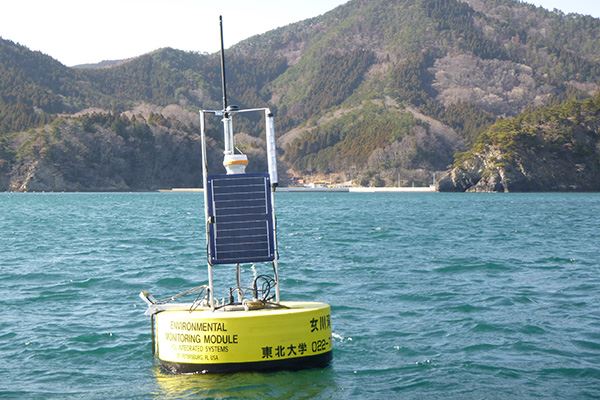
Upon arrival at the site, it’s important to take pictures, as they might help explain any anomalies in the data. In this photo, a YSI EMM700 Buoy is deployed in coastal waters.
After the side-by-side samples have been gathered, you can clean the sides of the sensors and the sonde bulkhead area, being careful not to disturb the sensor faces.
Now you are ready to test the sensors against standards to verify if they remain within specifications. If they are not, NOW clean the sensor faces and test again in the standards. This will tell you if the drift was caused by biofouling or actual sensor drift. These checks help ensure data integrity and inform future deployments.
9. Protect equipment between uses
Saltwater is hard on electronics and connectors. After retrieval:
- Clean and maintain the sonde and sensor connectors
- Rinse all components thoroughly with freshwater
- Dry and store the sonde according to the manufacturer’s instructions
- Recharge or remove batteries as needed
- Inspect cables and seals for wear
Proper post-use care can extend the life of your instrumentation. If you are using an EXO Sonde, this is the perfect time to ensure that your wet-mate connectors are clean and relubricated with silicone grease until they glisten. If you are using another manufacturer, double-check their recommendations.
We want to thoroughly rinse the instrument and sensors so that when they are stored, microorganisms do not continue to grow and cause trouble the next time you are ready to deploy the sonde; check out our storage blog for more information.
Never store an instrument with batteries installed; it's best to remove them and use a new set for the next deployment. Take this opportunity to test the cables and battery compartment seals on your handheld as well.
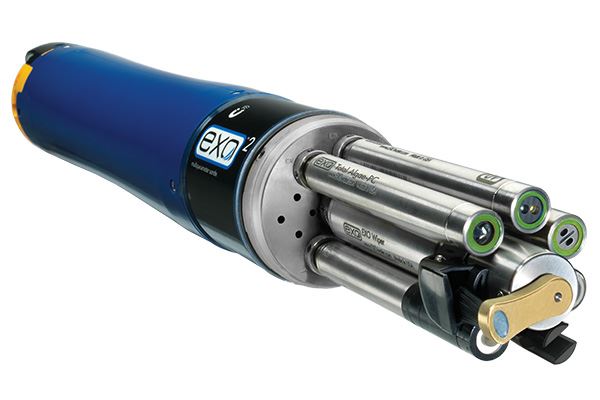
Water quality equipment should be thoroughly cleaned before storage to ensure microorganisms do not continue to grow.
10. Document everything
Good documentation ensures consistency and data traceability. Keep a log of:
- Photos, photos, photos
- Site coordinates and descriptions
- Deployment method and depth
- Calibration values and sensor configuration
- Maintenance and retrieval notes
- Observations or anomalies
Document everything you do! Field notes and metadata are essential for interpreting results and defending data quality.
Marine deployments—and most other deployments—require more than just dropping a sonde in the water. From careful planning to regular maintenance and QA/QC, these best practices help ensure your data holds up to scientific scrutiny. Whether new to coastal monitoring or managing a long-term program, following these tips can make your work more efficient—and your results more reliable.
If you have a follow-up question about monitoring in marine environments, please contact us—you can even schedule a free virtual consultation!
You can also check out our on-demand resources—including webinars and training programs—to learn more about water quality monitoring.
